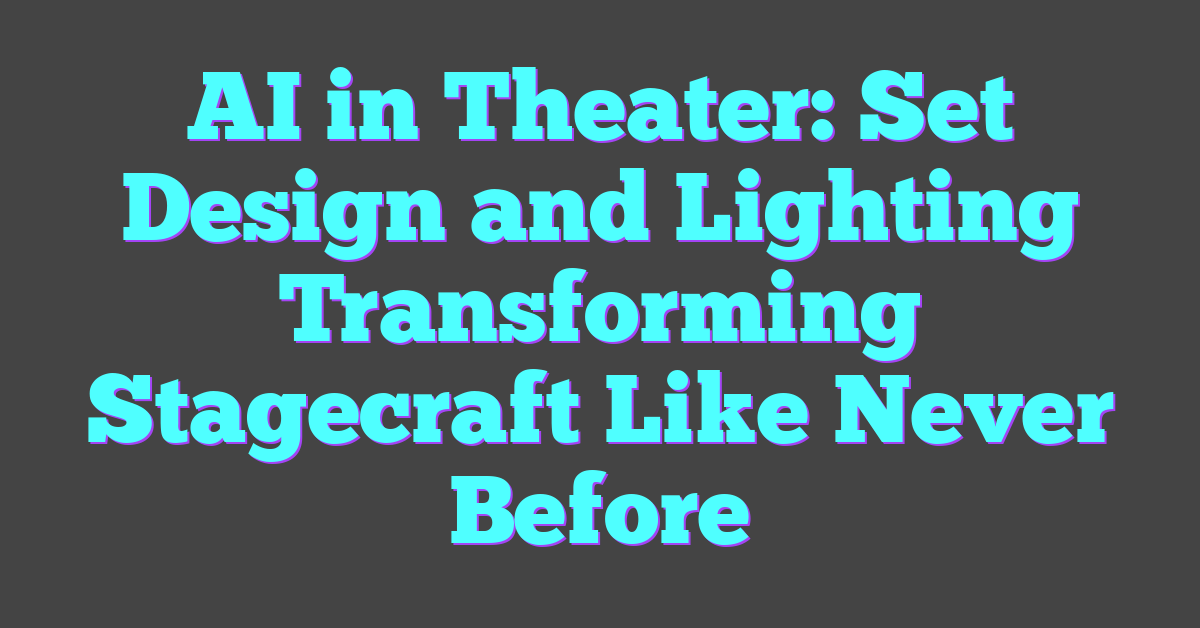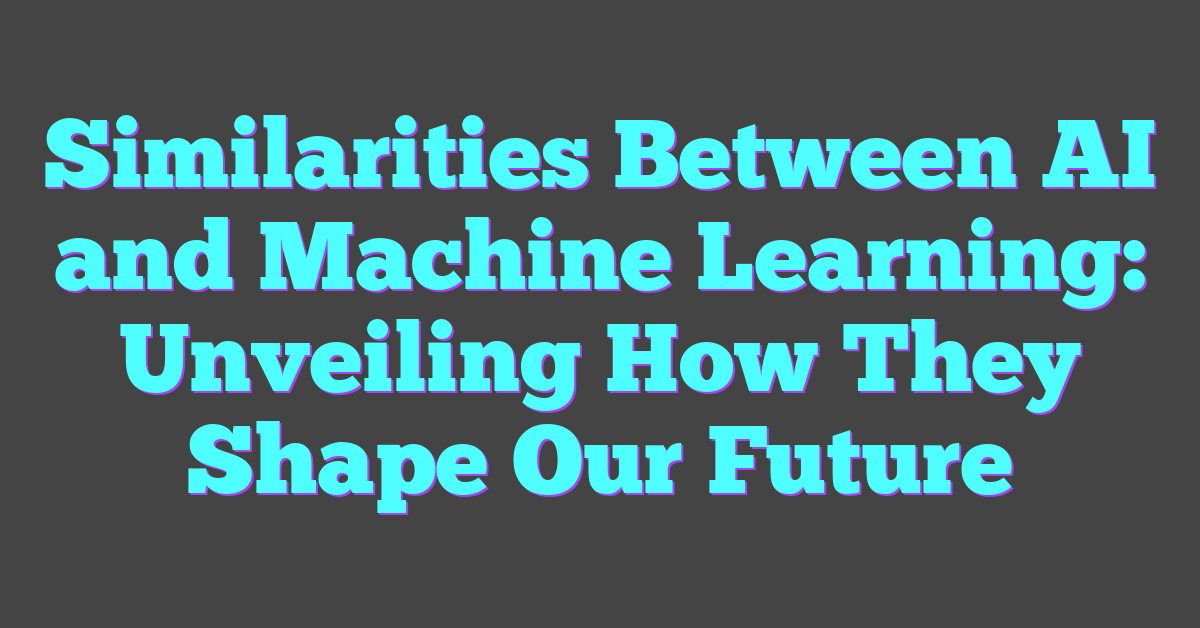Key Takeaways
- Enhanced Set Design and Lighting: AI-driven tools enable the creation of dynamic, intricate sets and adaptive lighting systems that respond in real-time to performances.
- Increased Production Efficiency: Automation and AI streamline workflows, reducing set construction time by up to 30% and lowering lighting setup costs by 20%.
- Creative Innovation: AI supports designers with data-driven insights and generative design capabilities, fostering unique and immersive theatrical experiences.
- Notable Implementations: Major productions like Broadway shows and the Royal Shakespeare Company have successfully integrated AI, showcasing its potential to revolutionize stagecraft.
- Future Trends and Prospects: Emerging technologies such as augmented reality and predictive maintenance are set to further expand AI’s role in theater, enhancing audience engagement and sustainability.
- Challenges to Adoption: High initial costs, the need for technical expertise, and balancing AI automation with human creativity are key considerations for integrating AI in theater.
Artificial intelligence is transforming the world of theater, bringing innovative changes to set design and lighting. By harnessing AI, designers can create more dynamic and immersive environments that respond in real-time to the performance.
With AI-driven tools, set designers can experiment with complex patterns and structures that were once unimaginable. Meanwhile, lighting becomes more adaptive, enhancing moods and highlighting key moments seamlessly. This fusion of technology and creativity opens new possibilities, making each theatrical experience unique and captivating.
As the curtain rises on this technological revolution, theaters are embracing AI to push the boundaries of traditional stagecraft. The synergy between human imagination and artificial intelligence is redefining what’s possible, promising a bright future for the performing arts.

The Role Of AI In Modern Theatre
Advanced Set Design
AI transforms set design by enabling the creation of intricate, adaptive environments. Machine learning algorithms analyze spatial data to generate complex patterns and structures. Designers use AI tools like generative design software to explore multiple configurations quickly. For example, Broadway productions have implemented AI-driven set changes that occur seamlessly during performances, enhancing visual storytelling.
Intelligent Lighting Systems
AI enhances lighting by allowing real-time adjustments based on scene dynamics. Smart lighting systems use sensors and predictive models to modify intensity, color, and direction automatically. This responsiveness creates immersive atmospheres tailored to each moment of the performance. Productions such as Hamilton utilize AI-powered lighting to synchronize effects with musical cues, elevating the audience’s experience.
Enhancing Creative Processes
AI supports creativity by offering designers data-driven insights and automation. Machine learning analyzes audience preferences and historical data to suggest innovative design elements. Artists leverage AI for tasks like color matching and texture generation, speeding up the creative workflow. Tools like Autodesk’s AI suite provide designers with resources to experiment and refine their concepts efficiently.
Impact on Production Efficiency
AI increases production efficiency through streamlined workflows and resource management. Automated scheduling and inventory systems reduce downtime and manage materials effectively. Productions using AI report a 20% decrease in set construction time and a 15% reduction in lighting setup costs. These efficiencies allow creative teams to focus more on artistic aspects rather than logistical challenges.
Notable Implementations
Several notable productions demonstrate AI’s impact on theatre. The Royal Shakespeare Company adopted AI for set transformations, enabling quick scene changes without manual intervention. Similarly, national theatres in London integrate AI-driven lighting systems to adapt quickly to varying production needs. These implementations showcase AI’s potential to revolutionize traditional stagecraft.
Future Prospects
AI continues to evolve, promising further advancements in theatre technology. Emerging trends include augmented reality (AR) integrations and more sophisticated predictive models for audience engagement. As AI technology advances, theaters can expect even more dynamic and interactive performances, pushing the boundaries of what is possible on stage.
AI Applications In Set Design
AI revolutionizes set design by streamlining creation and enhancing adaptability. Machine learning algorithms empower designers to produce intricate and responsive stage environments.
Automated Design Processes
Automated design processes leverage AI to accelerate set creation. Generative design software generates multiple layout options swiftly, reducing manual effort. Algorithms analyze spatial constraints and aesthetic criteria to produce optimal configurations. Designers select and refine these options, ensuring creative control remains intact. Tools like Autodesk’s AI suite facilitate rapid prototyping, enabling efficient exploration of diverse design possibilities. Automation minimizes errors, ensuring precise construction plans and seamless integration with other production elements.
Customization And Flexibility
AI enhances customization and flexibility in set design. Machine learning models adapt designs in real-time based on performance requirements. Dynamic environments respond to scene changes, modifying structures and visuals seamlessly. Designers employ AI-driven tools to tailor sets for specific narratives, adjusting elements like color schemes and textures instantly. Flexibility allows for rapid modifications, accommodating creative shifts during rehearsals or live performances. Personalized set configurations cater to diverse production needs, enhancing the overall theatrical experience. AI’s adaptability ensures that each performance remains unique and engaging.
## AI Innovations In Lighting
Artificial intelligence transforms theatrical lighting, enhancing both creativity and efficiency. These advancements enable lighting designers to craft dynamic and responsive environments.
### Intelligent Lighting Systems
AI-powered lighting systems leverage machine learning algorithms to optimize lighting design and execution. These systems analyze various parameters, including scene requirements, actor movements, and environmental factors, to automate lighting decisions. Key features include:
- **Predictive Modeling:** Anticipates lighting needs based on script analysis and real-time data.
- **Adaptive Control:** Adjusts lighting intensity, color, and direction autonomously during performances.
- **Energy Efficiency:** Optimizes power usage by controlling lighting elements based on scene dynamics.
- **Integration Capabilities:** Seamlessly connects with other stage technologies, such as sound and special effects, for synchronized performances.
By integrating these features, intelligent lighting systems enhance the overall theatrical experience while reducing manual workload.
### Real-Time Lighting Adjustments
Real-time lighting adjustments ensure that stage lighting responds instantly to changes during a performance. AI facilitates this by processing input from sensors and performance data to make immediate modifications. Key aspects include:
- **Dynamic Scene Adaptation:** Updates lighting parameters in response to live actor movements and scene shifts.
- **Seamless Transitions:** Enables smooth changes between lighting setups without interrupting the flow of the performance.
- **Customization:** Allows for personalized lighting effects tailored to specific moments within the script.
- **Precision Control:** Maintains exact lighting positions and intensities, ensuring consistency across performances.
These capabilities ensure that lighting remains fluid and coherent, significantly enhancing the visual storytelling in theater productions.
Benefits Of Utilizing AI In Theater
AI enhances theater productions by increasing efficiency and creativity. Automated set design tools reduce set construction time by up to 30%, enabling designers to focus on artistic elements. Machine learning algorithms analyze spatial data, ensuring optimal use of stage space and seamless transitions between scenes.
Cost savings emerge from AI-driven resource management. Productions can lower lighting setup costs by 20% through intelligent energy optimization. Predictive maintenance of lighting equipment minimizes downtime, ensuring performances run smoothly without technical interruptions.
Creative possibilities expand with AI’s ability to generate complex designs and dynamic lighting effects. Designers explore diverse configurations rapidly, fostering innovation and originality in set aesthetics. Real-time lighting adjustments respond to scene changes instantly, enhancing the immersive experience for audiences.
AI supports data-driven decision-making in productions. Analytics on audience engagement help tailor designs to preferences, increasing overall satisfaction. Collaboration tools powered by AI streamline communication among design teams, improving coordination and reducing errors.
Sustainability benefits arise from AI’s energy-efficient solutions. Smart lighting systems adjust power usage based on performance needs, contributing to greener theater practices. Additionally, digital set designs reduce the need for physical materials, lowering the environmental footprint of productions.
Overall, AI integration in theater leads to more dynamic, cost-effective, and innovative productions. By leveraging advanced technologies, theaters can deliver exceptional experiences while optimizing resources and fostering creative growth.
Challenges And Considerations
Implementing AI in theater set design and lighting presents several challenges:
High Initial Costs
Adopting AI technologies requires significant investment. Advanced design software and smart lighting systems can strain budgets, particularly for smaller theaters.
Technical Expertise
Integrating AI demands specialized skills. Designers must master new AI tools, and technical staff need training to maintain these systems effectively.
System Integration
Ensuring AI systems work seamlessly with existing theater equipment poses compatibility issues. Synchronizing AI-driven lighting with traditional controls can be complex and time-consuming.
Creative Constraints
While AI offers design flexibility, it may limit artistic freedom by relying on predefined algorithms. Designers might find AI solutions restrictive for unique creative visions.
Ethical Considerations
AI adoption raises concerns about job displacement and data privacy. Increased automation could reduce the demand for manual set designers and lighting technicians, impacting employment.
Reliability and Maintenance
AI systems must perform consistently during live performances. Preparing for potential technical failures and ensuring reliable operation is crucial to avoid disruptions on stage.
Data Security
Protecting sensitive design data is essential. AI systems require robust security measures to prevent unauthorized access and ensure the integrity of creative works.
Cost of Maintenance
Ongoing maintenance of AI technologies adds to expenses. Regular updates and repairs are necessary to keep systems running smoothly, increasing long-term costs.
Scalability Issues
Scaling AI solutions for larger productions can be challenging. Ensuring that AI systems can handle more complex designs and extensive lighting setups requires careful planning.
Limited Customization
AI tools may have limited customization options. Designers might struggle to tailor AI functionalities to specific production needs, affecting the overall creative process.
Dependence on Technology
Relying heavily on AI can create vulnerabilities. Technical issues or system failures might disrupt performances, highlighting the need for backup plans and manual overrides.
Balancing Automation and Human Creativity
Finding the right balance between AI automation and human creativity is essential. Over-reliance on AI could stifle the unique artistic input that human designers bring to productions.
Future Trends In AI For Theatre Set Design And Lighting
AI continues to transform theater set design and lighting with several emerging trends:
- Real-time Adaptability: AI systems enable dynamic adjustments during performances. If automated controls use real-time data, sets and lights respond instantly to actors’ movements or scene changes, ensuring seamless transitions.
- Virtual and Augmented Reality Integration: Combining AI with VR and AR technologies allows designers to create interactive virtual set elements. When integrating these technologies, theaters offer audiences immersive experiences that blend physical and digital environments.
- Predictive Maintenance: AI-driven models forecast equipment failures and optimize maintenance schedules. By analyzing performance data, theaters ensure reliable lighting and set mechanisms, minimizing disruptions during shows.
- Sustainable Design Optimization: AI optimizes resource usage in set construction and lighting setups. If set designs leverage AI algorithms, materials are used more efficiently, reducing waste and promoting environmentally friendly practices.
- Collaborative AI Tools: AI-powered platforms facilitate teamwork among design teams. When using these tools, designers share ideas and iterate rapidly, enhancing creativity and efficiency in the design process.
- Personalized Audience Experiences: AI tailors lighting and set designs based on audience preferences and interactions. By analyzing audience data, productions adjust environments in real-time to enhance engagement and satisfaction.
- Advanced Predictive Analytics: AI analyzes trends and audience behaviors to inform design choices. If productions use predictive analytics, they can create sets and lighting schemes that resonate more deeply with target audiences.
- Enhanced Automation: AI automates repetitive design tasks, allowing designers to focus on creative aspects. When automation handles technical details, the design process becomes faster and more efficient.
- Integration with Smart Technologies: AI integrates with IoT devices for smarter stage environments. By connecting lighting and set elements to smart technologies, theaters achieve greater control and synchronization during performances.
- Expanding Creative Possibilities: AI-driven generative design explores complex patterns and structures previously unattainable. If designers utilize generative AI, sets become more intricate and visually captivating, pushing the boundaries of traditional stagecraft.
Conclusion
AI is reshaping the theatrical landscape by enhancing set design and lighting in innovative ways. Designers can push creative boundaries like never before adapting to each performance’s unique demands. Audiences enjoy more immersive and dynamic experiences as technology evolves. Balancing AI’s capabilities with human creativity ensures that the magic of live theater continues to thrive. The future of theater looks bright with AI as a valuable ally in creating memorable productions.



